Perception of Obesity and Absenteeism in Healthcare Workers Report
VerifiedAdded on 2022/08/09
|12
|2406
|297
Report
AI Summary
This report presents a qualitative study conducted at a New Zealand healthcare institute, investigating the impact of obesity on absenteeism and stress levels among healthcare workers. The research employed semi-structured interviews with five participants and utilized thematic analysis to identify key themes. The study revealed that fatigue, stigma, and lack of organizational support were significant factors contributing to absenteeism. The findings highlighted a need for policy changes, health education, and a more supportive work environment to reduce obesity-related absenteeism and improve worker well-being. The report also acknowledges limitations such as a small sample size and suggests recommendations for future research, including a zero-tolerance policy to address stigma and promote healthier lifestyles. The report also provides relevant statistics and the methodology used for the research.
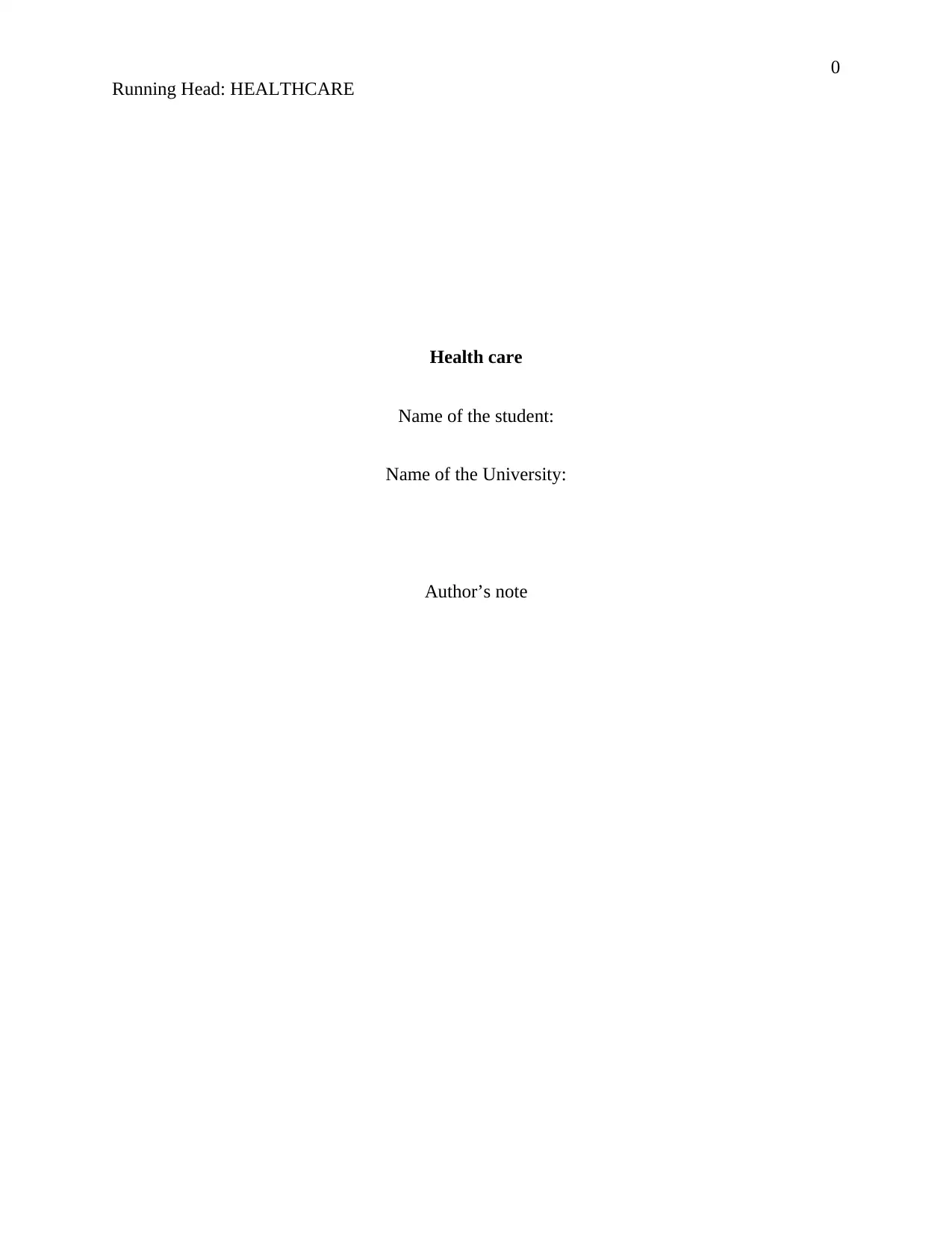
0
Running Head: HEALTHCARE
Health care
Name of the student:
Name of the University:
Author’s note
Running Head: HEALTHCARE
Health care
Name of the student:
Name of the University:
Author’s note
Paraphrase This Document
Need a fresh take? Get an instant paraphrase of this document with our AI Paraphraser
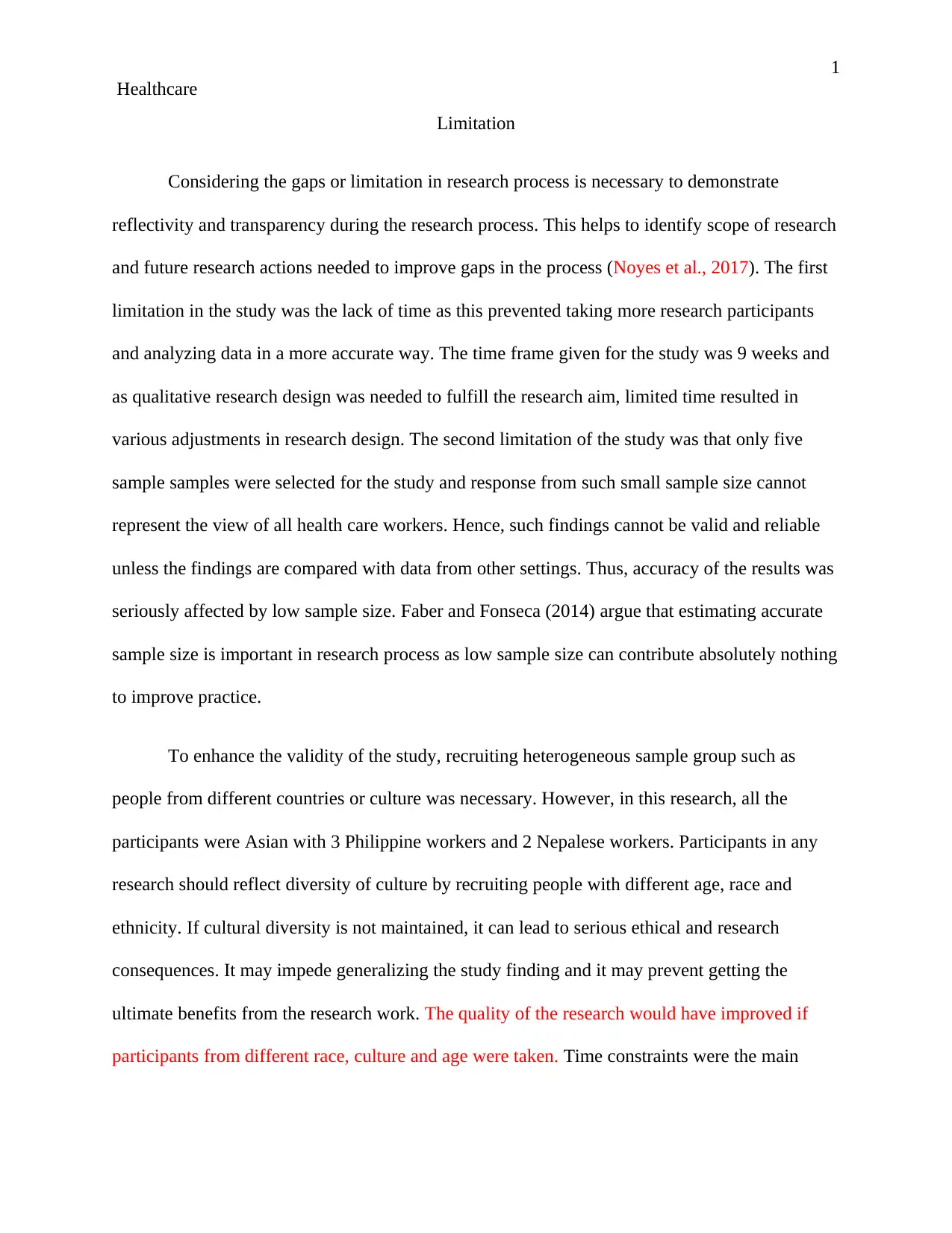
1
Healthcare
Limitation
Considering the gaps or limitation in research process is necessary to demonstrate
reflectivity and transparency during the research process. This helps to identify scope of research
and future research actions needed to improve gaps in the process (Noyes et al., 2017). The first
limitation in the study was the lack of time as this prevented taking more research participants
and analyzing data in a more accurate way. The time frame given for the study was 9 weeks and
as qualitative research design was needed to fulfill the research aim, limited time resulted in
various adjustments in research design. The second limitation of the study was that only five
sample samples were selected for the study and response from such small sample size cannot
represent the view of all health care workers. Hence, such findings cannot be valid and reliable
unless the findings are compared with data from other settings. Thus, accuracy of the results was
seriously affected by low sample size. Faber and Fonseca (2014) argue that estimating accurate
sample size is important in research process as low sample size can contribute absolutely nothing
to improve practice.
To enhance the validity of the study, recruiting heterogeneous sample group such as
people from different countries or culture was necessary. However, in this research, all the
participants were Asian with 3 Philippine workers and 2 Nepalese workers. Participants in any
research should reflect diversity of culture by recruiting people with different age, race and
ethnicity. If cultural diversity is not maintained, it can lead to serious ethical and research
consequences. It may impede generalizing the study finding and it may prevent getting the
ultimate benefits from the research work. The quality of the research would have improved if
participants from different race, culture and age were taken. Time constraints were the main
Healthcare
Limitation
Considering the gaps or limitation in research process is necessary to demonstrate
reflectivity and transparency during the research process. This helps to identify scope of research
and future research actions needed to improve gaps in the process (Noyes et al., 2017). The first
limitation in the study was the lack of time as this prevented taking more research participants
and analyzing data in a more accurate way. The time frame given for the study was 9 weeks and
as qualitative research design was needed to fulfill the research aim, limited time resulted in
various adjustments in research design. The second limitation of the study was that only five
sample samples were selected for the study and response from such small sample size cannot
represent the view of all health care workers. Hence, such findings cannot be valid and reliable
unless the findings are compared with data from other settings. Thus, accuracy of the results was
seriously affected by low sample size. Faber and Fonseca (2014) argue that estimating accurate
sample size is important in research process as low sample size can contribute absolutely nothing
to improve practice.
To enhance the validity of the study, recruiting heterogeneous sample group such as
people from different countries or culture was necessary. However, in this research, all the
participants were Asian with 3 Philippine workers and 2 Nepalese workers. Participants in any
research should reflect diversity of culture by recruiting people with different age, race and
ethnicity. If cultural diversity is not maintained, it can lead to serious ethical and research
consequences. It may impede generalizing the study finding and it may prevent getting the
ultimate benefits from the research work. The quality of the research would have improved if
participants from different race, culture and age were taken. Time constraints were the main
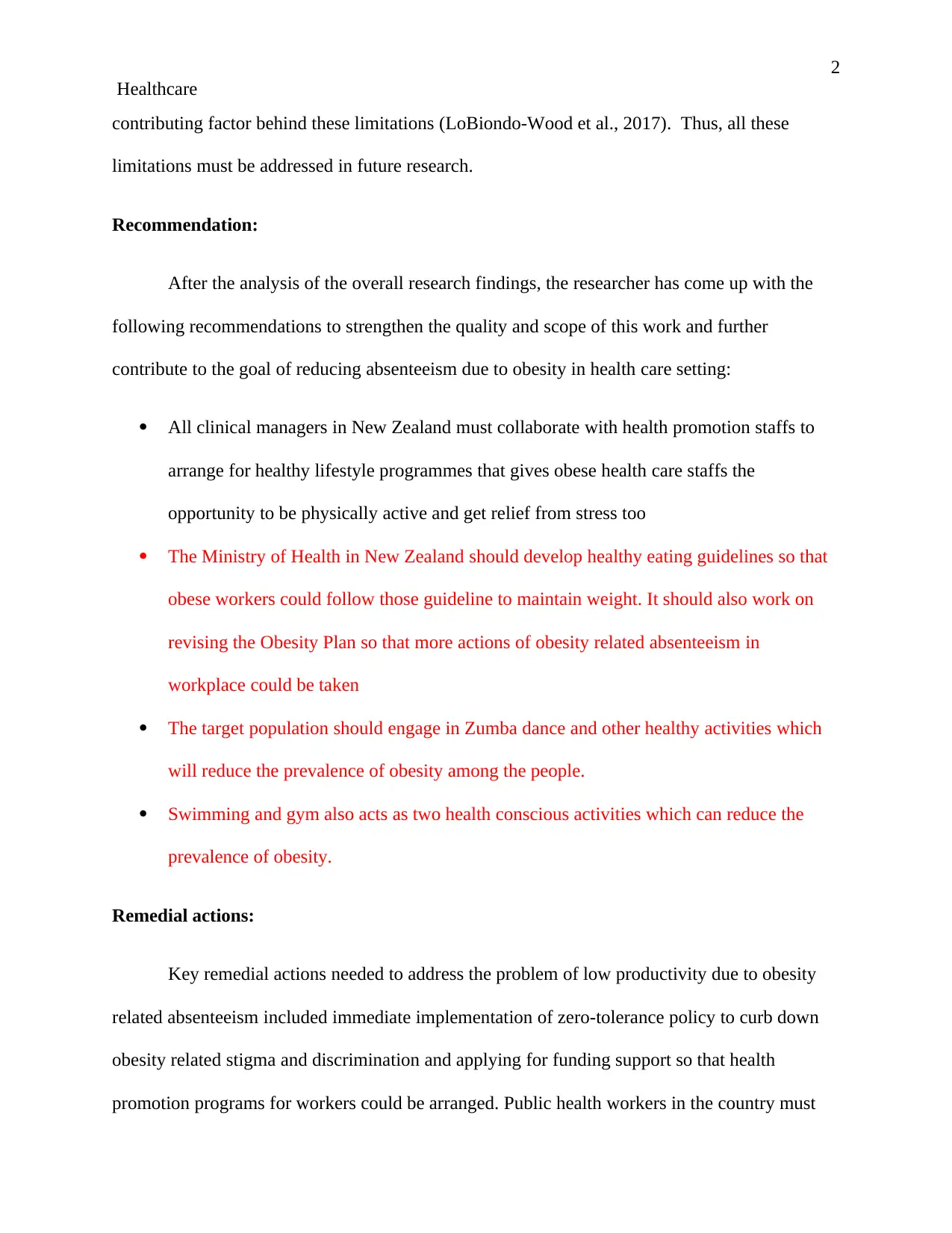
2
Healthcare
contributing factor behind these limitations (LoBiondo-Wood et al., 2017). Thus, all these
limitations must be addressed in future research.
Recommendation:
After the analysis of the overall research findings, the researcher has come up with the
following recommendations to strengthen the quality and scope of this work and further
contribute to the goal of reducing absenteeism due to obesity in health care setting:
All clinical managers in New Zealand must collaborate with health promotion staffs to
arrange for healthy lifestyle programmes that gives obese health care staffs the
opportunity to be physically active and get relief from stress too
The Ministry of Health in New Zealand should develop healthy eating guidelines so that
obese workers could follow those guideline to maintain weight. It should also work on
revising the Obesity Plan so that more actions of obesity related absenteeism in
workplace could be taken
The target population should engage in Zumba dance and other healthy activities which
will reduce the prevalence of obesity among the people.
Swimming and gym also acts as two health conscious activities which can reduce the
prevalence of obesity.
Remedial actions:
Key remedial actions needed to address the problem of low productivity due to obesity
related absenteeism included immediate implementation of zero-tolerance policy to curb down
obesity related stigma and discrimination and applying for funding support so that health
promotion programs for workers could be arranged. Public health workers in the country must
Healthcare
contributing factor behind these limitations (LoBiondo-Wood et al., 2017). Thus, all these
limitations must be addressed in future research.
Recommendation:
After the analysis of the overall research findings, the researcher has come up with the
following recommendations to strengthen the quality and scope of this work and further
contribute to the goal of reducing absenteeism due to obesity in health care setting:
All clinical managers in New Zealand must collaborate with health promotion staffs to
arrange for healthy lifestyle programmes that gives obese health care staffs the
opportunity to be physically active and get relief from stress too
The Ministry of Health in New Zealand should develop healthy eating guidelines so that
obese workers could follow those guideline to maintain weight. It should also work on
revising the Obesity Plan so that more actions of obesity related absenteeism in
workplace could be taken
The target population should engage in Zumba dance and other healthy activities which
will reduce the prevalence of obesity among the people.
Swimming and gym also acts as two health conscious activities which can reduce the
prevalence of obesity.
Remedial actions:
Key remedial actions needed to address the problem of low productivity due to obesity
related absenteeism included immediate implementation of zero-tolerance policy to curb down
obesity related stigma and discrimination and applying for funding support so that health
promotion programs for workers could be arranged. Public health workers in the country must
⊘ This is a preview!⊘
Do you want full access?
Subscribe today to unlock all pages.

Trusted by 1+ million students worldwide
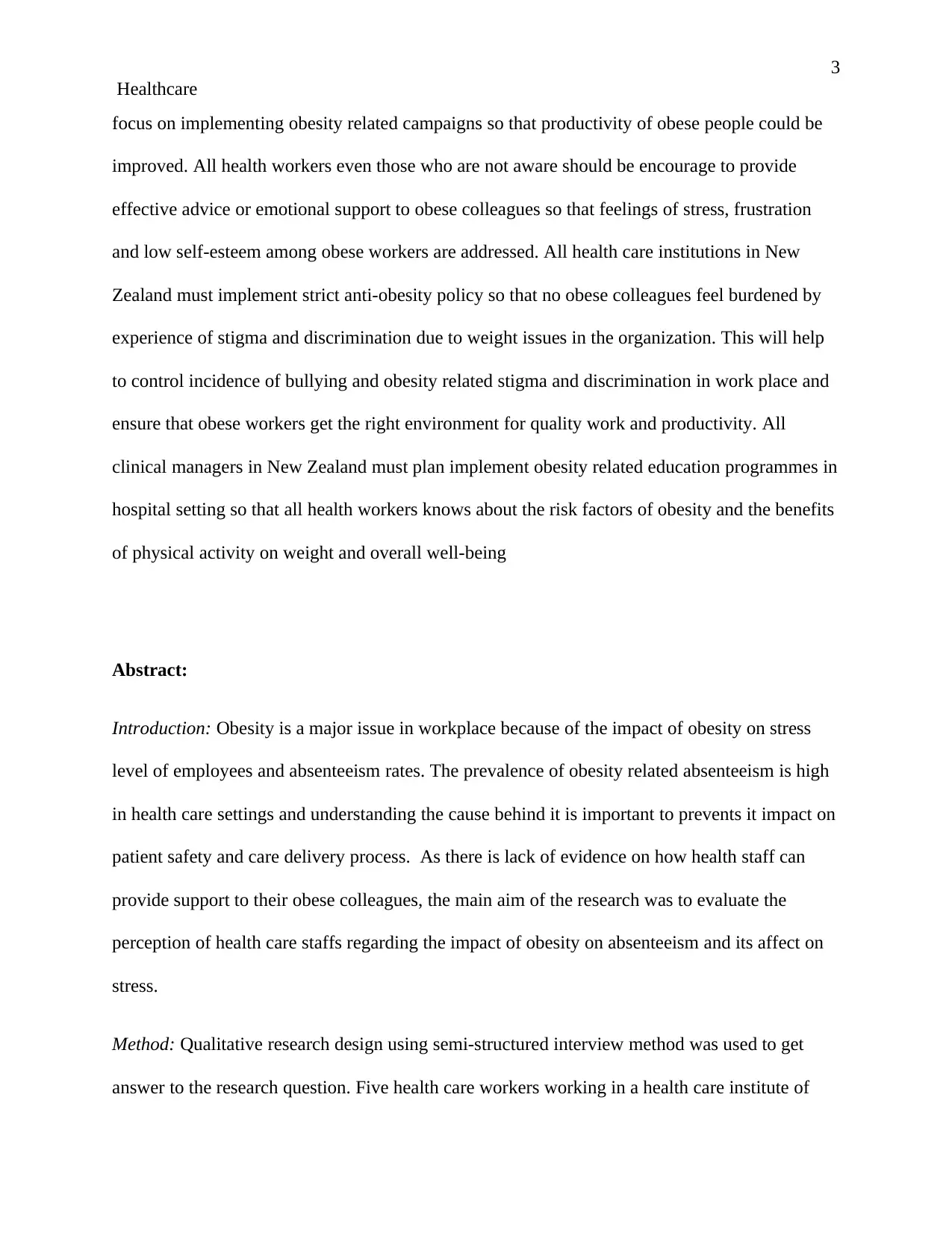
3
Healthcare
focus on implementing obesity related campaigns so that productivity of obese people could be
improved. All health workers even those who are not aware should be encourage to provide
effective advice or emotional support to obese colleagues so that feelings of stress, frustration
and low self-esteem among obese workers are addressed. All health care institutions in New
Zealand must implement strict anti-obesity policy so that no obese colleagues feel burdened by
experience of stigma and discrimination due to weight issues in the organization. This will help
to control incidence of bullying and obesity related stigma and discrimination in work place and
ensure that obese workers get the right environment for quality work and productivity. All
clinical managers in New Zealand must plan implement obesity related education programmes in
hospital setting so that all health workers knows about the risk factors of obesity and the benefits
of physical activity on weight and overall well-being
Abstract:
Introduction: Obesity is a major issue in workplace because of the impact of obesity on stress
level of employees and absenteeism rates. The prevalence of obesity related absenteeism is high
in health care settings and understanding the cause behind it is important to prevents it impact on
patient safety and care delivery process. As there is lack of evidence on how health staff can
provide support to their obese colleagues, the main aim of the research was to evaluate the
perception of health care staffs regarding the impact of obesity on absenteeism and its affect on
stress.
Method: Qualitative research design using semi-structured interview method was used to get
answer to the research question. Five health care workers working in a health care institute of
Healthcare
focus on implementing obesity related campaigns so that productivity of obese people could be
improved. All health workers even those who are not aware should be encourage to provide
effective advice or emotional support to obese colleagues so that feelings of stress, frustration
and low self-esteem among obese workers are addressed. All health care institutions in New
Zealand must implement strict anti-obesity policy so that no obese colleagues feel burdened by
experience of stigma and discrimination due to weight issues in the organization. This will help
to control incidence of bullying and obesity related stigma and discrimination in work place and
ensure that obese workers get the right environment for quality work and productivity. All
clinical managers in New Zealand must plan implement obesity related education programmes in
hospital setting so that all health workers knows about the risk factors of obesity and the benefits
of physical activity on weight and overall well-being
Abstract:
Introduction: Obesity is a major issue in workplace because of the impact of obesity on stress
level of employees and absenteeism rates. The prevalence of obesity related absenteeism is high
in health care settings and understanding the cause behind it is important to prevents it impact on
patient safety and care delivery process. As there is lack of evidence on how health staff can
provide support to their obese colleagues, the main aim of the research was to evaluate the
perception of health care staffs regarding the impact of obesity on absenteeism and its affect on
stress.
Method: Qualitative research design using semi-structured interview method was used to get
answer to the research question. Five health care workers working in a health care institute of
Paraphrase This Document
Need a fresh take? Get an instant paraphrase of this document with our AI Paraphraser
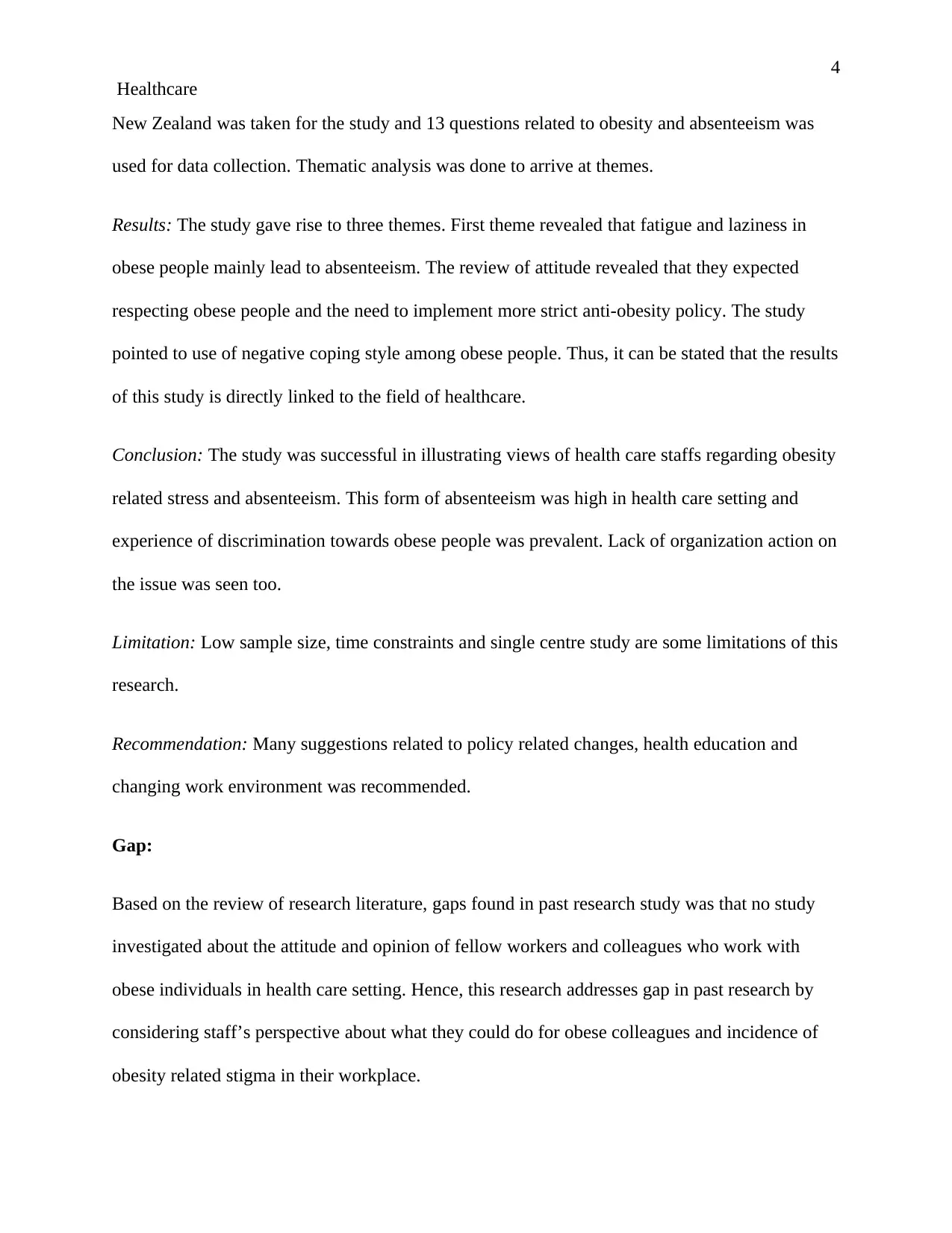
4
Healthcare
New Zealand was taken for the study and 13 questions related to obesity and absenteeism was
used for data collection. Thematic analysis was done to arrive at themes.
Results: The study gave rise to three themes. First theme revealed that fatigue and laziness in
obese people mainly lead to absenteeism. The review of attitude revealed that they expected
respecting obese people and the need to implement more strict anti-obesity policy. The study
pointed to use of negative coping style among obese people. Thus, it can be stated that the results
of this study is directly linked to the field of healthcare.
Conclusion: The study was successful in illustrating views of health care staffs regarding obesity
related stress and absenteeism. This form of absenteeism was high in health care setting and
experience of discrimination towards obese people was prevalent. Lack of organization action on
the issue was seen too.
Limitation: Low sample size, time constraints and single centre study are some limitations of this
research.
Recommendation: Many suggestions related to policy related changes, health education and
changing work environment was recommended.
Gap:
Based on the review of research literature, gaps found in past research study was that no study
investigated about the attitude and opinion of fellow workers and colleagues who work with
obese individuals in health care setting. Hence, this research addresses gap in past research by
considering staff’s perspective about what they could do for obese colleagues and incidence of
obesity related stigma in their workplace.
Healthcare
New Zealand was taken for the study and 13 questions related to obesity and absenteeism was
used for data collection. Thematic analysis was done to arrive at themes.
Results: The study gave rise to three themes. First theme revealed that fatigue and laziness in
obese people mainly lead to absenteeism. The review of attitude revealed that they expected
respecting obese people and the need to implement more strict anti-obesity policy. The study
pointed to use of negative coping style among obese people. Thus, it can be stated that the results
of this study is directly linked to the field of healthcare.
Conclusion: The study was successful in illustrating views of health care staffs regarding obesity
related stress and absenteeism. This form of absenteeism was high in health care setting and
experience of discrimination towards obese people was prevalent. Lack of organization action on
the issue was seen too.
Limitation: Low sample size, time constraints and single centre study are some limitations of this
research.
Recommendation: Many suggestions related to policy related changes, health education and
changing work environment was recommended.
Gap:
Based on the review of research literature, gaps found in past research study was that no study
investigated about the attitude and opinion of fellow workers and colleagues who work with
obese individuals in health care setting. Hence, this research addresses gap in past research by
considering staff’s perspective about what they could do for obese colleagues and incidence of
obesity related stigma in their workplace.
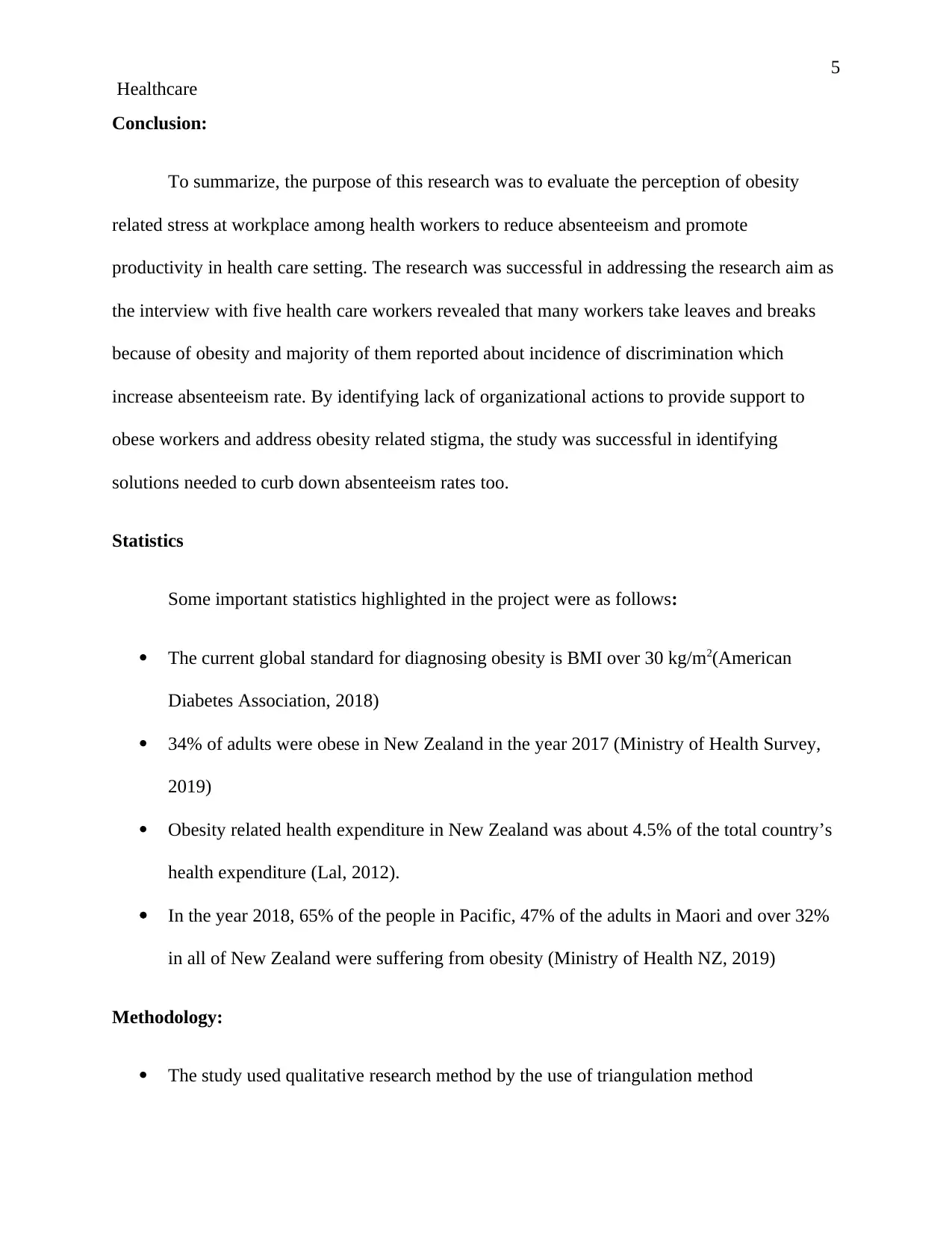
5
Healthcare
Conclusion:
To summarize, the purpose of this research was to evaluate the perception of obesity
related stress at workplace among health workers to reduce absenteeism and promote
productivity in health care setting. The research was successful in addressing the research aim as
the interview with five health care workers revealed that many workers take leaves and breaks
because of obesity and majority of them reported about incidence of discrimination which
increase absenteeism rate. By identifying lack of organizational actions to provide support to
obese workers and address obesity related stigma, the study was successful in identifying
solutions needed to curb down absenteeism rates too.
Statistics
Some important statistics highlighted in the project were as follows:
The current global standard for diagnosing obesity is BMI over 30 kg/m2(American
Diabetes Association, 2018)
34% of adults were obese in New Zealand in the year 2017 (Ministry of Health Survey,
2019)
Obesity related health expenditure in New Zealand was about 4.5% of the total country’s
health expenditure (Lal, 2012).
In the year 2018, 65% of the people in Pacific, 47% of the adults in Maori and over 32%
in all of New Zealand were suffering from obesity (Ministry of Health NZ, 2019)
Methodology:
The study used qualitative research method by the use of triangulation method
Healthcare
Conclusion:
To summarize, the purpose of this research was to evaluate the perception of obesity
related stress at workplace among health workers to reduce absenteeism and promote
productivity in health care setting. The research was successful in addressing the research aim as
the interview with five health care workers revealed that many workers take leaves and breaks
because of obesity and majority of them reported about incidence of discrimination which
increase absenteeism rate. By identifying lack of organizational actions to provide support to
obese workers and address obesity related stigma, the study was successful in identifying
solutions needed to curb down absenteeism rates too.
Statistics
Some important statistics highlighted in the project were as follows:
The current global standard for diagnosing obesity is BMI over 30 kg/m2(American
Diabetes Association, 2018)
34% of adults were obese in New Zealand in the year 2017 (Ministry of Health Survey,
2019)
Obesity related health expenditure in New Zealand was about 4.5% of the total country’s
health expenditure (Lal, 2012).
In the year 2018, 65% of the people in Pacific, 47% of the adults in Maori and over 32%
in all of New Zealand were suffering from obesity (Ministry of Health NZ, 2019)
Methodology:
The study used qualitative research method by the use of triangulation method
⊘ This is a preview!⊘
Do you want full access?
Subscribe today to unlock all pages.

Trusted by 1+ million students worldwide
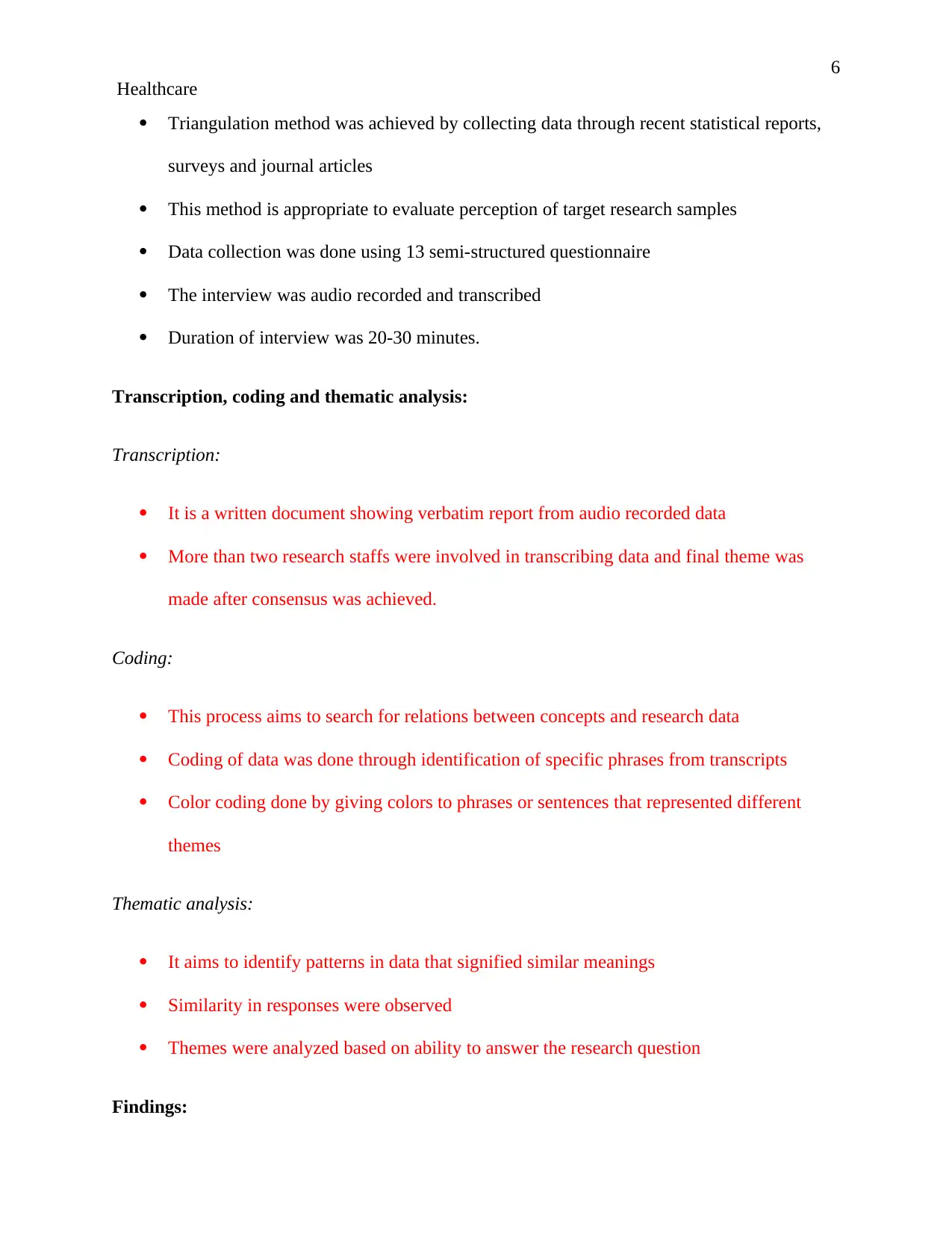
6
Healthcare
Triangulation method was achieved by collecting data through recent statistical reports,
surveys and journal articles
This method is appropriate to evaluate perception of target research samples
Data collection was done using 13 semi-structured questionnaire
The interview was audio recorded and transcribed
Duration of interview was 20-30 minutes.
Transcription, coding and thematic analysis:
Transcription:
It is a written document showing verbatim report from audio recorded data
More than two research staffs were involved in transcribing data and final theme was
made after consensus was achieved.
Coding:
This process aims to search for relations between concepts and research data
Coding of data was done through identification of specific phrases from transcripts
Color coding done by giving colors to phrases or sentences that represented different
themes
Thematic analysis:
It aims to identify patterns in data that signified similar meanings
Similarity in responses were observed
Themes were analyzed based on ability to answer the research question
Findings:
Healthcare
Triangulation method was achieved by collecting data through recent statistical reports,
surveys and journal articles
This method is appropriate to evaluate perception of target research samples
Data collection was done using 13 semi-structured questionnaire
The interview was audio recorded and transcribed
Duration of interview was 20-30 minutes.
Transcription, coding and thematic analysis:
Transcription:
It is a written document showing verbatim report from audio recorded data
More than two research staffs were involved in transcribing data and final theme was
made after consensus was achieved.
Coding:
This process aims to search for relations between concepts and research data
Coding of data was done through identification of specific phrases from transcripts
Color coding done by giving colors to phrases or sentences that represented different
themes
Thematic analysis:
It aims to identify patterns in data that signified similar meanings
Similarity in responses were observed
Themes were analyzed based on ability to answer the research question
Findings:
Paraphrase This Document
Need a fresh take? Get an instant paraphrase of this document with our AI Paraphraser
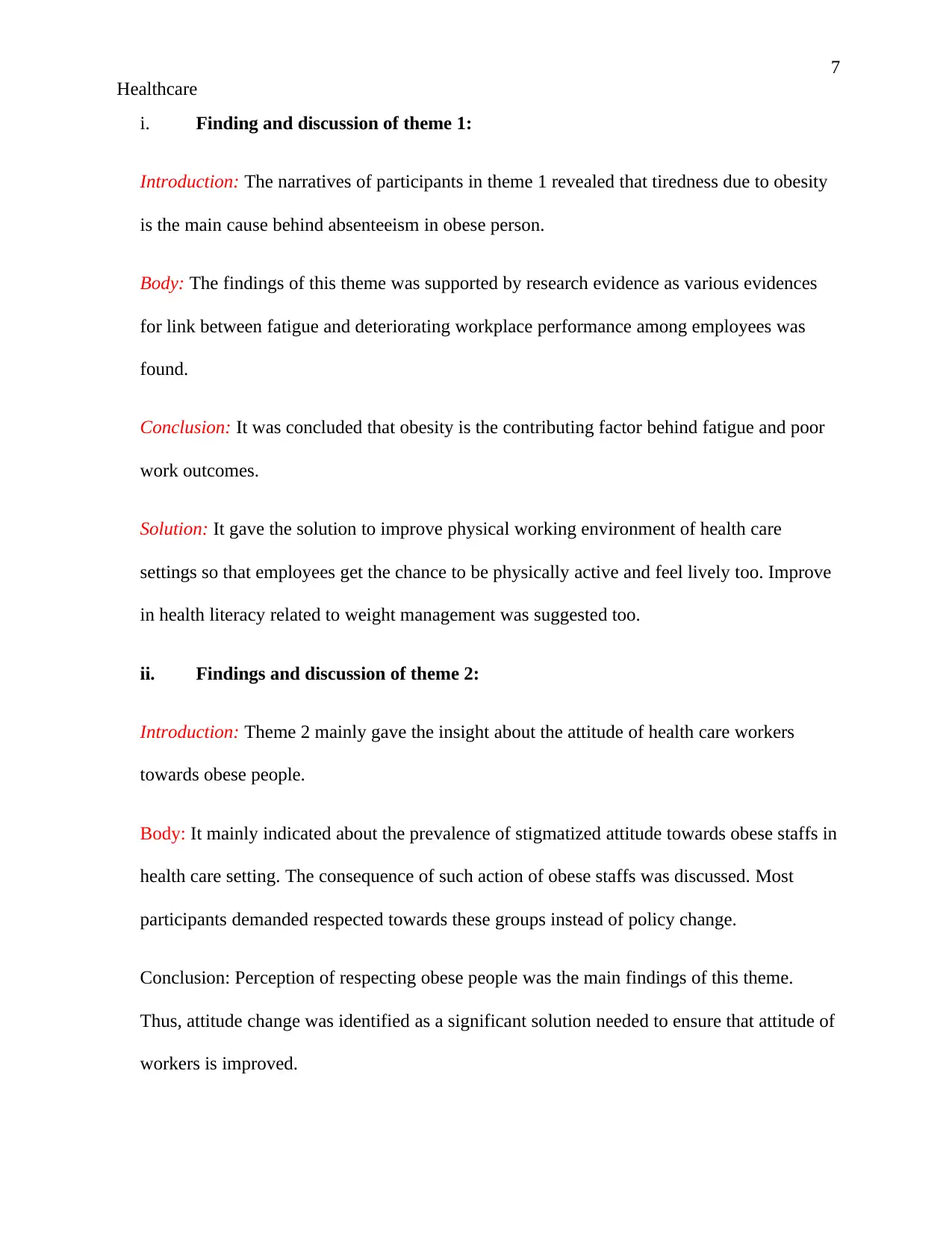
7
Healthcare
i. Finding and discussion of theme 1:
Introduction: The narratives of participants in theme 1 revealed that tiredness due to obesity
is the main cause behind absenteeism in obese person.
Body: The findings of this theme was supported by research evidence as various evidences
for link between fatigue and deteriorating workplace performance among employees was
found.
Conclusion: It was concluded that obesity is the contributing factor behind fatigue and poor
work outcomes.
Solution: It gave the solution to improve physical working environment of health care
settings so that employees get the chance to be physically active and feel lively too. Improve
in health literacy related to weight management was suggested too.
ii. Findings and discussion of theme 2:
Introduction: Theme 2 mainly gave the insight about the attitude of health care workers
towards obese people.
Body: It mainly indicated about the prevalence of stigmatized attitude towards obese staffs in
health care setting. The consequence of such action of obese staffs was discussed. Most
participants demanded respected towards these groups instead of policy change.
Conclusion: Perception of respecting obese people was the main findings of this theme.
Thus, attitude change was identified as a significant solution needed to ensure that attitude of
workers is improved.
Healthcare
i. Finding and discussion of theme 1:
Introduction: The narratives of participants in theme 1 revealed that tiredness due to obesity
is the main cause behind absenteeism in obese person.
Body: The findings of this theme was supported by research evidence as various evidences
for link between fatigue and deteriorating workplace performance among employees was
found.
Conclusion: It was concluded that obesity is the contributing factor behind fatigue and poor
work outcomes.
Solution: It gave the solution to improve physical working environment of health care
settings so that employees get the chance to be physically active and feel lively too. Improve
in health literacy related to weight management was suggested too.
ii. Findings and discussion of theme 2:
Introduction: Theme 2 mainly gave the insight about the attitude of health care workers
towards obese people.
Body: It mainly indicated about the prevalence of stigmatized attitude towards obese staffs in
health care setting. The consequence of such action of obese staffs was discussed. Most
participants demanded respected towards these groups instead of policy change.
Conclusion: Perception of respecting obese people was the main findings of this theme.
Thus, attitude change was identified as a significant solution needed to ensure that attitude of
workers is improved.
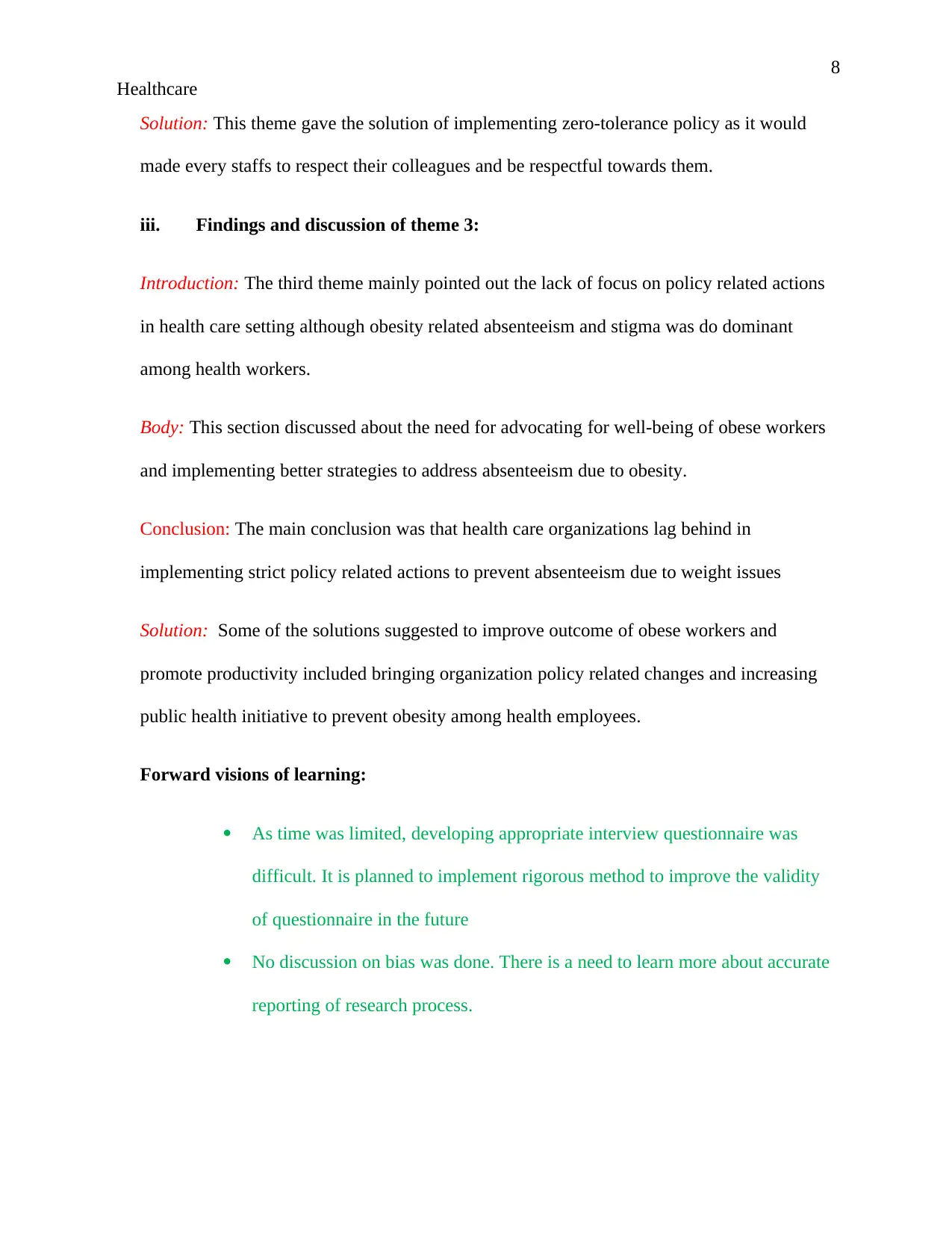
8
Healthcare
Solution: This theme gave the solution of implementing zero-tolerance policy as it would
made every staffs to respect their colleagues and be respectful towards them.
iii. Findings and discussion of theme 3:
Introduction: The third theme mainly pointed out the lack of focus on policy related actions
in health care setting although obesity related absenteeism and stigma was do dominant
among health workers.
Body: This section discussed about the need for advocating for well-being of obese workers
and implementing better strategies to address absenteeism due to obesity.
Conclusion: The main conclusion was that health care organizations lag behind in
implementing strict policy related actions to prevent absenteeism due to weight issues
Solution: Some of the solutions suggested to improve outcome of obese workers and
promote productivity included bringing organization policy related changes and increasing
public health initiative to prevent obesity among health employees.
Forward visions of learning:
As time was limited, developing appropriate interview questionnaire was
difficult. It is planned to implement rigorous method to improve the validity
of questionnaire in the future
No discussion on bias was done. There is a need to learn more about accurate
reporting of research process.
Healthcare
Solution: This theme gave the solution of implementing zero-tolerance policy as it would
made every staffs to respect their colleagues and be respectful towards them.
iii. Findings and discussion of theme 3:
Introduction: The third theme mainly pointed out the lack of focus on policy related actions
in health care setting although obesity related absenteeism and stigma was do dominant
among health workers.
Body: This section discussed about the need for advocating for well-being of obese workers
and implementing better strategies to address absenteeism due to obesity.
Conclusion: The main conclusion was that health care organizations lag behind in
implementing strict policy related actions to prevent absenteeism due to weight issues
Solution: Some of the solutions suggested to improve outcome of obese workers and
promote productivity included bringing organization policy related changes and increasing
public health initiative to prevent obesity among health employees.
Forward visions of learning:
As time was limited, developing appropriate interview questionnaire was
difficult. It is planned to implement rigorous method to improve the validity
of questionnaire in the future
No discussion on bias was done. There is a need to learn more about accurate
reporting of research process.
⊘ This is a preview!⊘
Do you want full access?
Subscribe today to unlock all pages.

Trusted by 1+ million students worldwide
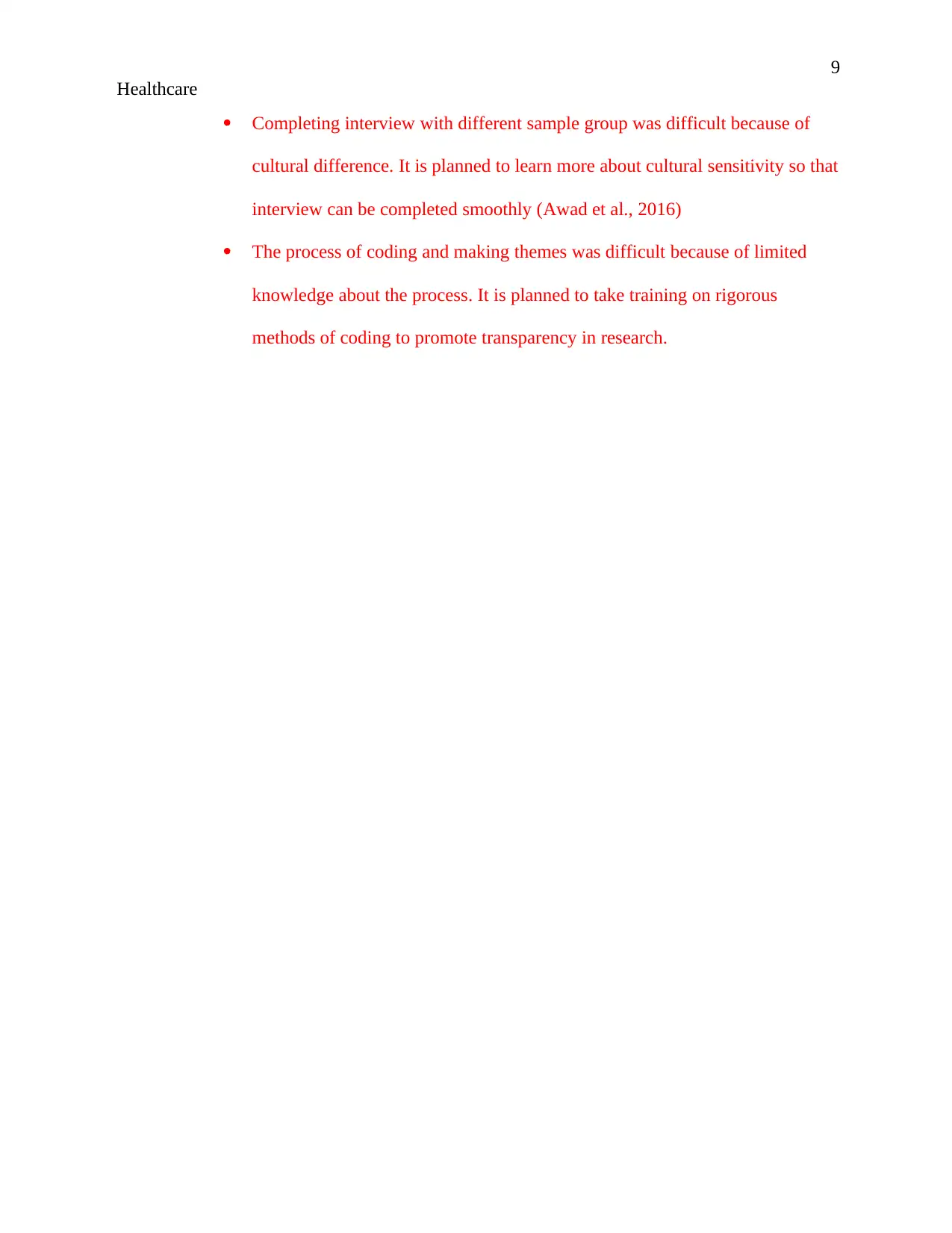
9
Healthcare
Completing interview with different sample group was difficult because of
cultural difference. It is planned to learn more about cultural sensitivity so that
interview can be completed smoothly (Awad et al., 2016)
The process of coding and making themes was difficult because of limited
knowledge about the process. It is planned to take training on rigorous
methods of coding to promote transparency in research.
Healthcare
Completing interview with different sample group was difficult because of
cultural difference. It is planned to learn more about cultural sensitivity so that
interview can be completed smoothly (Awad et al., 2016)
The process of coding and making themes was difficult because of limited
knowledge about the process. It is planned to take training on rigorous
methods of coding to promote transparency in research.
Paraphrase This Document
Need a fresh take? Get an instant paraphrase of this document with our AI Paraphraser
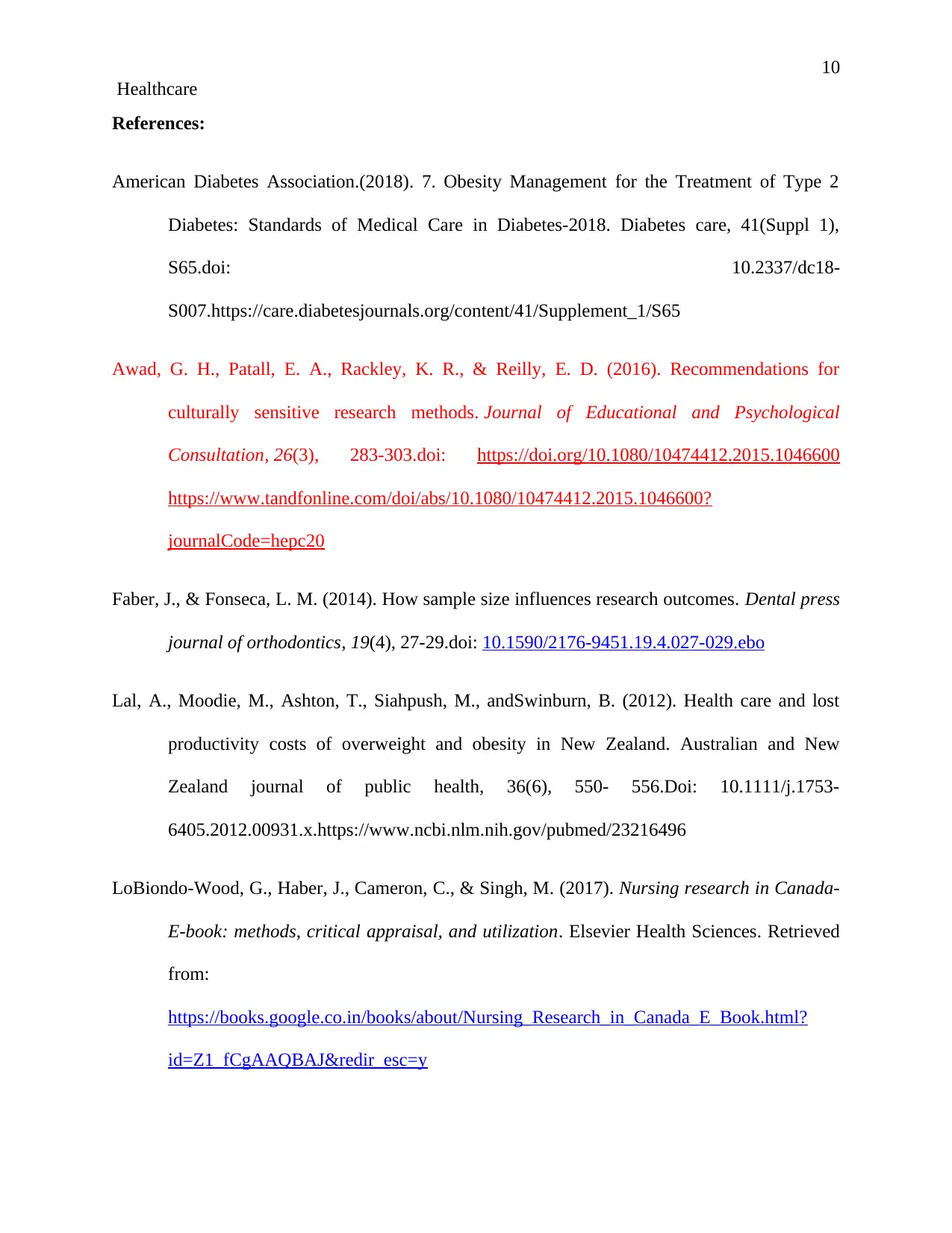
10
Healthcare
References:
American Diabetes Association.(2018). 7. Obesity Management for the Treatment of Type 2
Diabetes: Standards of Medical Care in Diabetes-2018. Diabetes care, 41(Suppl 1),
S65.doi: 10.2337/dc18-
S007.https://care.diabetesjournals.org/content/41/Supplement_1/S65
Awad, G. H., Patall, E. A., Rackley, K. R., & Reilly, E. D. (2016). Recommendations for
culturally sensitive research methods. Journal of Educational and Psychological
Consultation, 26(3), 283-303.doi: https://doi.org/10.1080/10474412.2015.1046600
https://www.tandfonline.com/doi/abs/10.1080/10474412.2015.1046600?
journalCode=hepc20
Faber, J., & Fonseca, L. M. (2014). How sample size influences research outcomes. Dental press
journal of orthodontics, 19(4), 27-29.doi: 10.1590/2176-9451.19.4.027-029.ebo
Lal, A., Moodie, M., Ashton, T., Siahpush, M., andSwinburn, B. (2012). Health care and lost
productivity costs of overweight and obesity in New Zealand. Australian and New
Zealand journal of public health, 36(6), 550- 556.Doi: 10.1111/j.1753-
6405.2012.00931.x.https://www.ncbi.nlm.nih.gov/pubmed/23216496
LoBiondo-Wood, G., Haber, J., Cameron, C., & Singh, M. (2017). Nursing research in Canada-
E-book: methods, critical appraisal, and utilization. Elsevier Health Sciences. Retrieved
from:
https://books.google.co.in/books/about/Nursing_Research_in_Canada_E_Book.html?
id=Z1_fCgAAQBAJ&redir_esc=y
Healthcare
References:
American Diabetes Association.(2018). 7. Obesity Management for the Treatment of Type 2
Diabetes: Standards of Medical Care in Diabetes-2018. Diabetes care, 41(Suppl 1),
S65.doi: 10.2337/dc18-
S007.https://care.diabetesjournals.org/content/41/Supplement_1/S65
Awad, G. H., Patall, E. A., Rackley, K. R., & Reilly, E. D. (2016). Recommendations for
culturally sensitive research methods. Journal of Educational and Psychological
Consultation, 26(3), 283-303.doi: https://doi.org/10.1080/10474412.2015.1046600
https://www.tandfonline.com/doi/abs/10.1080/10474412.2015.1046600?
journalCode=hepc20
Faber, J., & Fonseca, L. M. (2014). How sample size influences research outcomes. Dental press
journal of orthodontics, 19(4), 27-29.doi: 10.1590/2176-9451.19.4.027-029.ebo
Lal, A., Moodie, M., Ashton, T., Siahpush, M., andSwinburn, B. (2012). Health care and lost
productivity costs of overweight and obesity in New Zealand. Australian and New
Zealand journal of public health, 36(6), 550- 556.Doi: 10.1111/j.1753-
6405.2012.00931.x.https://www.ncbi.nlm.nih.gov/pubmed/23216496
LoBiondo-Wood, G., Haber, J., Cameron, C., & Singh, M. (2017). Nursing research in Canada-
E-book: methods, critical appraisal, and utilization. Elsevier Health Sciences. Retrieved
from:
https://books.google.co.in/books/about/Nursing_Research_in_Canada_E_Book.html?
id=Z1_fCgAAQBAJ&redir_esc=y
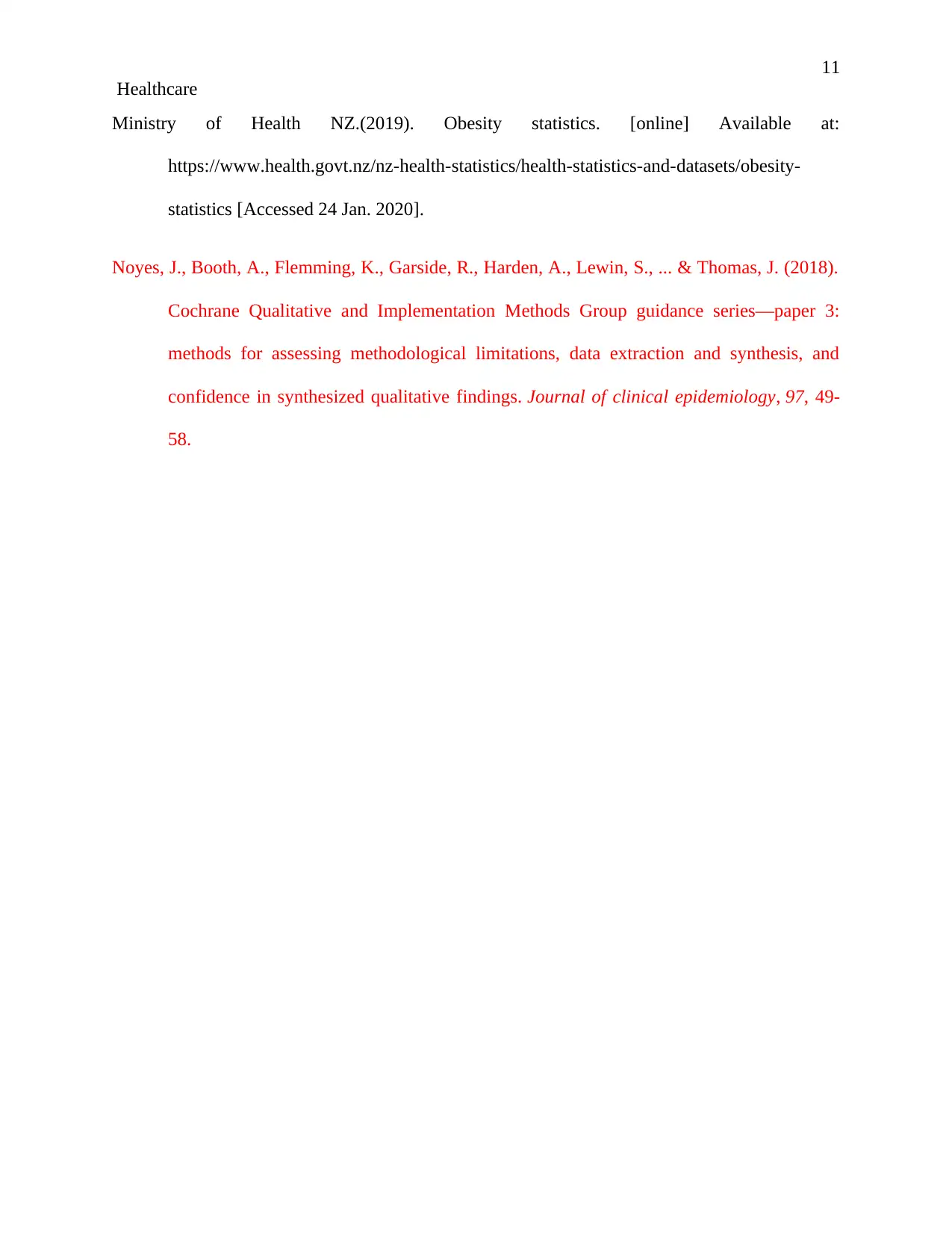
11
Healthcare
Ministry of Health NZ.(2019). Obesity statistics. [online] Available at:
https://www.health.govt.nz/nz-health-statistics/health-statistics-and-datasets/obesity-
statistics [Accessed 24 Jan. 2020].
Noyes, J., Booth, A., Flemming, K., Garside, R., Harden, A., Lewin, S., ... & Thomas, J. (2018).
Cochrane Qualitative and Implementation Methods Group guidance series—paper 3:
methods for assessing methodological limitations, data extraction and synthesis, and
confidence in synthesized qualitative findings. Journal of clinical epidemiology, 97, 49-
58.
Healthcare
Ministry of Health NZ.(2019). Obesity statistics. [online] Available at:
https://www.health.govt.nz/nz-health-statistics/health-statistics-and-datasets/obesity-
statistics [Accessed 24 Jan. 2020].
Noyes, J., Booth, A., Flemming, K., Garside, R., Harden, A., Lewin, S., ... & Thomas, J. (2018).
Cochrane Qualitative and Implementation Methods Group guidance series—paper 3:
methods for assessing methodological limitations, data extraction and synthesis, and
confidence in synthesized qualitative findings. Journal of clinical epidemiology, 97, 49-
58.
⊘ This is a preview!⊘
Do you want full access?
Subscribe today to unlock all pages.

Trusted by 1+ million students worldwide
1 out of 12
Related Documents
Your All-in-One AI-Powered Toolkit for Academic Success.
+13062052269
info@desklib.com
Available 24*7 on WhatsApp / Email
![[object Object]](/_next/static/media/star-bottom.7253800d.svg)
Unlock your academic potential
Copyright © 2020–2025 A2Z Services. All Rights Reserved. Developed and managed by ZUCOL.





